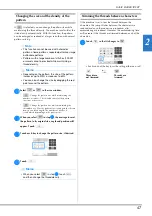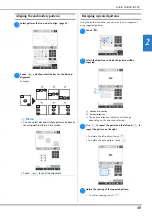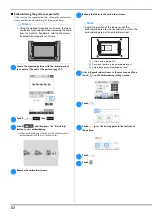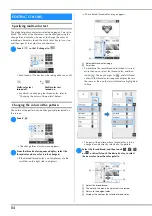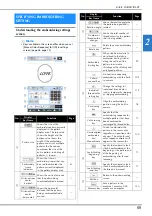
BASIC EMBROIDERY
61
2
Fabric/stabilizer compatibility chart
Hooping the fabric in the embroidery frame
Fabric/
Garment
No. of Backing Pieces
No. of Topping
Pieces
Comments
Terry cloth
1 tear-away
1 water-soluble
Increase density and/or satin stitch width.
Fine details and small lettering tend to get
caught in the terry loops.
Satin jacket
Heavy lining: None
Light or no lining: 1 tear-
away
None
If garment slips in frame, causing alignment
problems, wrap inner frame with masking
tape or fabric bias tape. This provides a rough
surface to grip garment and also helps
minimize frame burn.
Cotton
sheeting
1 tear-away
None
High-density or highly detailed designs may
require more backing. If so, use two pieces of
lightweight backing instead of one piece of
heavy backing.
Denim
1 tear-away
None
Reduce speed if needle begins to heat up and
the thread breaks.
Headwear
Optional
Optional
Change needles more often than usual
because the buckram backing dulls needles
faster. A lightweight tear-away backing helps
reduce thread breaks and regulates thread
tension. Use a topping on corduroy or foam
cap fronts.
Dress shirt
(woven)
1 tear-away
None
High-density or highly detailed designs may
require more backing. If so, use two pieces of
lightweight backing instead of one piece of
heavy backing.
Golf shirt
1 cut-away or iron-on
cut-away
Optional
Use topping for designs containing small
lettering or a lot of detail, and also for piqué
knits.
Canton
fleece
1 tear-away
Optional
Use a topping if the garment has a textured
surface, such as a basketweave or
pronounced twill.
Canvas
1 tear-away
None
Frame tightly.
Corduroy
1 tear-away
1 water-soluble
A higher stitch density or more under
stitches, as well as a topping, may be
necessary to prevent stitches from sinking
into the fabric.
Lingerie or
silk
1 or 2 lightweight tear-
away
Optional
Reduce embroidery speed. The thread
tension should be low. Use topping for
designs with high detail or small lettering. For
very fine fabrics, use a thinner thread. Avoid
extremely narrow satin stitching on letters or
details; instead increase satin stitch width or
use a bean stitch. Gently remove (don’t pull)
backing and topping from garment.
Sweater knit
1 cut-away or iron-on
cut-away
1 water-soluble
Use tightly woven organza or curtain fabric
in a matching color as a backing for bulky or
“holey” knits.
Sweatshirt
1 cut-away or adhesive
tear-away
Optional
Highly detailed designs may require two
layers of lightweight cut-away stabilizer. Use
a topping on extra-thick fabrics or with fine-
detail designs.
T-shirt
1 light-weight cut-away
or iron-on cut-away
Optional
Use a topping on designs with fine detail or
small lettering. Tensions should be light.
Avoid stitch-heavy designs.
Note
• Due to the wide variety of fabrics and stabilizers
available, the above information should be used as
guideline only. If unsure of a particular fabric/
stabilizer combination, please embroider test a
sample prior to the finished garment.
Note
• If the fabric is not taut, the pattern may be
misaligned or the fabric may pucker. Follow the
procedure described below to firmly smooth the
fabric in the embroidery frame so that the fabric is
not loose. In addition, be sure to work on a level
surface when putting the fabric in the embroidery
frame.
Fabric/
Garment
No. of Backing Pieces
No. of Topping
Pieces
Comments

